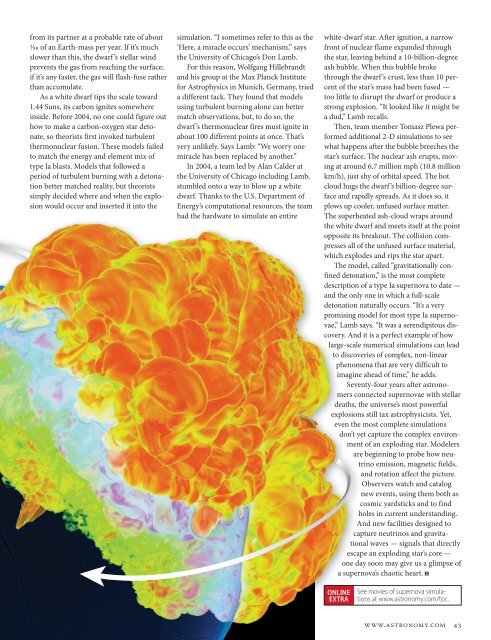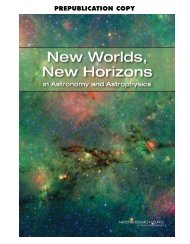STELLAR BOMB - The Department of Astronomy & Astrophysics ...
STELLAR BOMB - The Department of Astronomy & Astrophysics ...
STELLAR BOMB - The Department of Astronomy & Astrophysics ...
- No tags were found...
Create successful ePaper yourself
Turn your PDF publications into a flip-book with our unique Google optimized e-Paper software.
from its partner at a probable rate <strong>of</strong> about⅓0 <strong>of</strong> an Earth-mass per year. If it’s muchslower than this, the dwarf ’s stellar windprevents the gas from reaching the surface;if it’s any faster, the gas will flash-fuse ratherthan accumulate.As a white dwarf tips the scale toward1.44 Suns, its carbon ignites somewhereinside. Before 2004, no one could figure outhow to make a carbon-oxygen star detonate,so theorists first invoked turbulentthermonuclear fusion. <strong>The</strong>se models failedto match the energy and element mix <strong>of</strong>type Ia blasts. Models that followed aperiod <strong>of</strong> turbulent burning with a detonationbetter matched reality, but theoristssimply decided where and when the explosionwould occur and inserted it into thesimulation. “I sometimes refer to this as the‘Here, a miracle occurs’ mechanism,” saysthe University <strong>of</strong> Chicago’s Don Lamb.For this reason, Wolfgang Hillebrandtand his group at the Max Planck Institutefor <strong>Astrophysics</strong> in Munich, Germany, trieda different tack. <strong>The</strong>y found that modelsusing turbulent burning alone can bettermatch observations, but, to do so, thedwarf ’s thermonuclear fires must ignite inabout 100 different points at once. That’svery unlikely. Says Lamb: “We worry onemiracle has been replaced by another.”In 2004, a team led by Alan Calder atthe University <strong>of</strong> Chicago including Lamb,stumbled onto a way to blow up a whitedwarf. Thanks to the U.S. <strong>Department</strong> <strong>of</strong>Energy’s computational resources, the teamhad the hardware to simulate an entirewhite-dwarf star. After ignition, a narrowfront <strong>of</strong> nuclear flame expanded throughthe star, leaving behind a 10-billion-degreeash bubble. When this bubble brokethrough the dwarf ’s crust, less than 10 percent<strong>of</strong> the star’s mass had been fused —too little to disrupt the dwarf or produce astrong explosion. “It looked like it might bea dud,” Lamb recalls.<strong>The</strong>n, team member Tomasz Plewa performedadditional 2-D simulations to seewhat happens after the bubble breeches thestar’s surface. <strong>The</strong> nuclear ash erupts, movingat around 6.7 million mph (10.8 millionkm/h), just shy <strong>of</strong> orbital speed. <strong>The</strong> hotcloud hugs the dwarf ’s billion-degree surfaceand rapidly spreads. As it does so, itplows up cooler, unfused surface matter.<strong>The</strong> superheated ash-cloud wraps aroundthe white dwarf and meets itself at the pointopposite its breakout. <strong>The</strong> collision compressesall <strong>of</strong> the unfused surface material,which explodes and rips the star apart.<strong>The</strong> model, called “gravitationally confineddetonation,” is the most completedescription <strong>of</strong> a type Ia supernova to date —and the only one in which a full-scaledetonation naturally occurs. “It’s a verypromising model for most type Ia supernovae,”Lamb says. “It was a serendipitous discovery.And it is a perfect example <strong>of</strong> howlarge-scale numerical simulations can leadto discoveries <strong>of</strong> complex, non-linearphenomena that are very difficult toimagine ahead <strong>of</strong> time,” he adds.Seventy-four years after astronomersconnected supernovae with stellardeaths, the universe’s most powerfulexplosions still tax astrophysicists. Yet,even the most complete simulationsdon’t yet capture the complex environment<strong>of</strong> an exploding star. Modelersare beginning to probe how neutrinoemission, magnetic fields,and rotation affect the picture.Observers watch and catalognew events, using them both ascosmic yardsticks and to findholes in current understanding.And new facilities designed tocapture neutrinos and gravitationalwaves — signals that directlyescape an exploding star’s core —one day soon may give us a glimpse <strong>of</strong>a supernova’s chaotic heart.ONLINEEXTRASee movies <strong>of</strong> supernova simulationsat www.astronomy.com/toc.www.astronomy.com 43ASY-SE0307.indd 431/30/07 11:06:06 AM
















